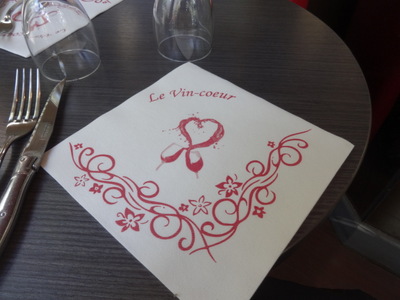
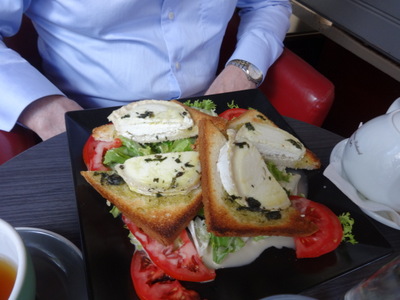 We settled at Le Vin-Coeur, "the wine-heart," which I think was intended to be a pun on "le vainqueur," "the victor."
We settled at Le Vin-Coeur, "the wine-heart," which I think was intended to be a pun on "le vainqueur," "the victor."Friday, 22 June, Porcelain and Aroma
Written 29 August 2018
Our expedition for the day was to visit the porcelain works in Sèvres, just outside Paris, at the far end of the Pont de Sèvres, the Sèvres Bridge (which we sailed under on our way down the Seine earlier in the trip).
While David slept in, I ran errands. In addition to breakfast, I went to the supermarket and picked up more butter and cheese and a couple of toiletries David wanted. Then, when David finally emerged, we walked over to Oberkampf and caught the #9 metro line and took it all the way to its southwest terminus, Pont de Sèvres, three stops beyond the actual city limits. Prospects for lunch seemed better on the near side of the bridge, so we went in search sustenance before crossing over.

 We settled at Le Vin-Coeur, "the wine-heart," which I think was intended to be a pun on "le vainqueur," "the victor."
We settled at Le Vin-Coeur, "the wine-heart," which I think was intended to be a pun on "le vainqueur," "the victor."
David ordered the goat-cheese salad he's so fond of and got this huge array of of slabs of goat cheese on toasted sliced bread, which he pronounced delicious. What you see is mostly what he got, but there were also walnuts lurking underneath.
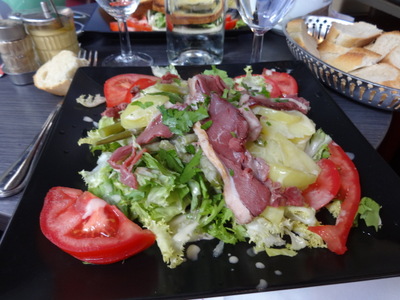
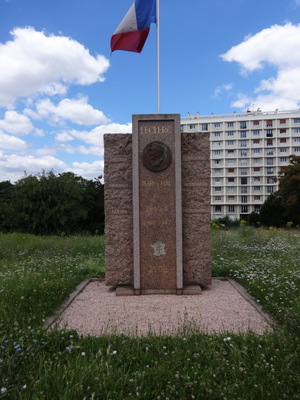 I had the salade Landaise (a combination I'm very fond of). Greens with tomatoes, warm cooked potatoes, onions, confit poultry gizzards, duck-breast ham, and green beans (lots of places were putting green beans in almost all their salads; they were in season).
I had the salade Landaise (a combination I'm very fond of). Greens with tomatoes, warm cooked potatoes, onions, confit poultry gizzards, duck-breast ham, and green beans (lots of places were putting green beans in almost all their salads; they were in season).
The menu must get a lot of tourists, because each item on it was subtitled in English, and it included some real howlers! For example, my salad was said to contain "candied gizzards," "beurre maître d'hôtel" was translated "buttered butler sauce," and skate's wing was translated (and I really don't get this one) "wing of lentil." David keeps telling me I should start a business translating menus for a fee.
Once we finished lunch, we set off to cross the bridge. I strapped my Tilley hat on fore and aft (and a good thing, too, as it was blowing a gale down the river). Near the Paris end of the bridge we encountered the monument to Philippe Leclerc de Hauteclocque (1902–1947, usually just called "Leclerc"), Marshal of France. The monument was presumably placed just there because the main approach to the bridge from the Paris side is the Avenue du Général Leclerc.
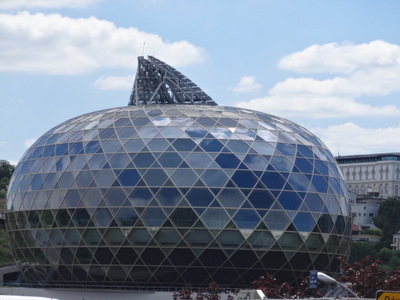
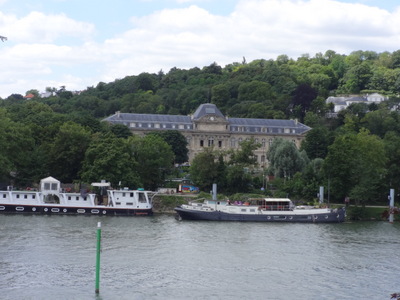
Two views from the bridge. Upstream, on the downstream tip of the Île Seguin, is this amazing building, which we had also seen from the cruise ship. It's a music and performing arts center called "La Seine Musicale," which I think must be intended to be a pun on "the music scene." We were told on the cruise that the sort of sail-shaped object revolves around it, following the sun.
Downstream and angling across to the far bank is our destination, the Sèvres porcelain works. I had hoped we'd get to see the manufacturing process, but that's open to tours only during school vacation, i.e.c July and August. All we were able to tour was the National Museum of Ceramics, which was quite enough to fill the time available.
Written 30 August 2018
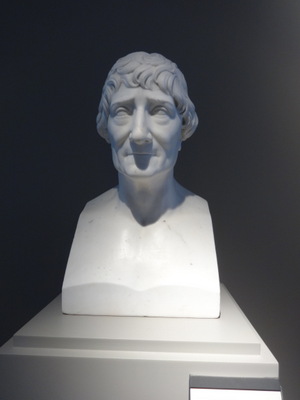
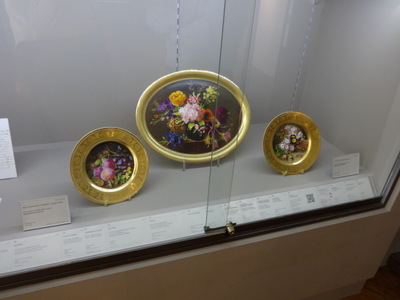 Here, at the left, we have a bust (in porcelain, of course), by Jean-Jacques Feuchères, of Alexandre Brongniart (1770-1847, director of the Manufacture de Sevres 1800–1847 and founder of the museum. He looks to me like a cheerful and interesting person.
Here, at the left, we have a bust (in porcelain, of course), by Jean-Jacques Feuchères, of Alexandre Brongniart (1770-1847, director of the Manufacture de Sevres 1800–1847 and founder of the museum. He looks to me like a cheerful and interesting person.
At the right are some beautiful examples of painted plates and a platter, also made here, with gilded rims. Lovely display items, but it would make me dizzy to try to eat off them.
The photos I present here are only a tiny, and strongly biased, sample of what was on display. The majority of my photos were actually of large panels of text, as the museum began with displays of some of the earliest ceramic artifacts known and proceeded, world region by world region, through the development of ceramic materials, techniques, and applications, from ancient history to the modern era. The amount of information was overwhelming—no way we could read it all and still have time to look at everything, so I took photos to peruse later. Most are in good enough focus to read once you blow them up. Let me know if you'd like to see any—I can send you the images.
In the meantime, I show here only a few of my favorites, or as in the case below, my disfavorites.
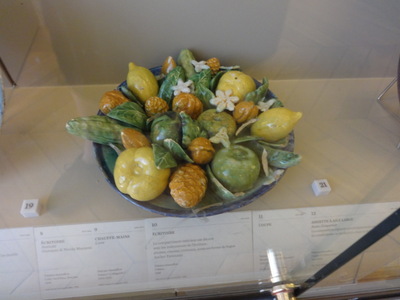
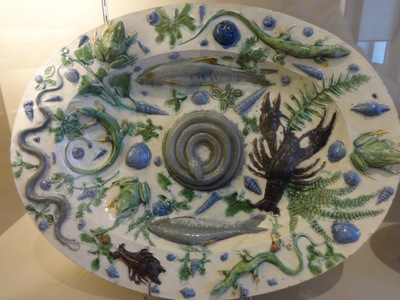 Here are two of the many, many items I've seen over the years that, IMHO, give faience a bad name. For decades, I actually thought "faience" was the name for ugly, roughly executed ceramics in the shape of fruits, vegetables, and wildlife, including terrines and tureens in the shape of cabbages, turkeys, boar's heads, and geese. Only on our 2015 Viking cruise in Portugal did I learn that it's actually a technique for painting the china before it's glazed. All those dazzling Portuguese architectural tiles, and many beautiful museum pieces, are faience, as are the little square tiles David and I made on that cruise (in that case, we're back to the ugly and roughly executed, but then I don't expect anyone to want to put them in a museum).
Here are two of the many, many items I've seen over the years that, IMHO, give faience a bad name. For decades, I actually thought "faience" was the name for ugly, roughly executed ceramics in the shape of fruits, vegetables, and wildlife, including terrines and tureens in the shape of cabbages, turkeys, boar's heads, and geese. Only on our 2015 Viking cruise in Portugal did I learn that it's actually a technique for painting the china before it's glazed. All those dazzling Portuguese architectural tiles, and many beautiful museum pieces, are faience, as are the little square tiles David and I made on that cruise (in that case, we're back to the ugly and roughly executed, but then I don't expect anyone to want to put them in a museum).
At the left is a fruit bowl, perfectly useless because it's already full of solidly attached fake ceramic fruit. At the right an also pretty useless platter decorated with snakes, lizards, frogs, fishes, crayfish, mollusc shells, and greenery. At least it can be hung on a wall, so as not to take up useful table space. I've seen several examples of the same sort of thing but much more realisically executed.
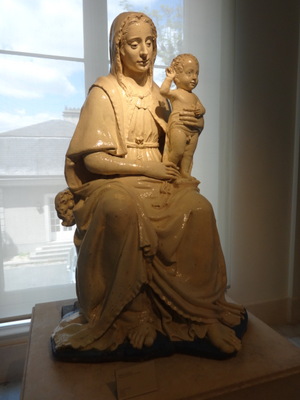
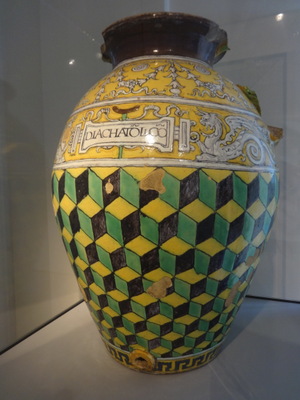 A few more historical examples before I move on the the "modern" section. At the left is a lovely enameled terra cotta madonna and child, maybe three feet high, labeled "Giovanni Della Robbia? (1394–1451)" and "France?"
A few more historical examples before I move on the the "modern" section. At the left is a lovely enameled terra cotta madonna and child, maybe three feet high, labeled "Giovanni Della Robbia? (1394–1451)" and "France?"
At the right is a huge apothecary jar with "Diachatolico" written across it. It's labeled "studio of Della Robbia, Florence." I've poked around on the web, but I haven't been able to figure out what "diachatolico" means; the only hits just refer to it as something written on apothecary jars. Any clues?
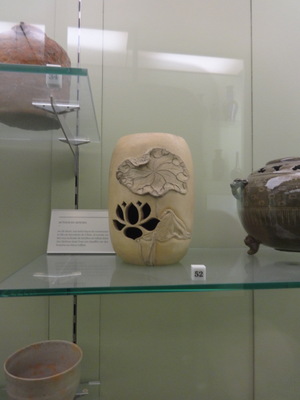
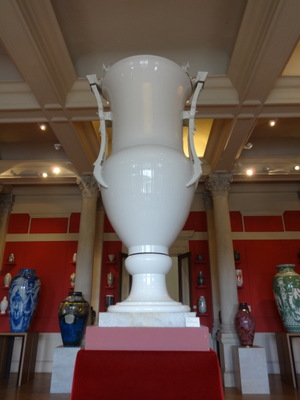 This little "tea warmer" was in one of the Asian sections. It's six or eight inches high and depicts a water lily, presumably Nelumbo as the withered leaf at the right is shown drooping from its stem rather than floating on the water surface. The bloom is cut out. A candle or small fire was lit inside, getting air and emiting light through the petals of the bloom, and a small teapot was set on top. The label seemed to say that water was actually heated on it to make tea, rather than just kept warm there. (My regular readers will already know that I'm a sucker for glass and ceramics depicting realistic plant life.)
This little "tea warmer" was in one of the Asian sections. It's six or eight inches high and depicts a water lily, presumably Nelumbo as the withered leaf at the right is shown drooping from its stem rather than floating on the water surface. The bloom is cut out. A candle or small fire was lit inside, getting air and emiting light through the petals of the bloom, and a small teapot was set on top. The label seemed to say that water was actually heated on it to make tea, rather than just kept warm there. (My regular readers will already know that I'm a sucker for glass and ceramics depicting realistic plant life.)
Once we had gone all the way through the historic side of the museum, we walked back across the central lobby to the "modern" side, where the Manufacture displays products of its workshop that it's particularly proud of. Pride of place in the center of the rirst room was given to this gigantic "Neptune vase" (no dimensions given, but probably 10 feet high), the largest ever produced at Sèvres, which was displayed at the "Exposition Universelle" of 1867. It was apparently produced by the then innovative technique of "compressed-air pouring." I don't know how that worked, but perhaps compressed air was used to drive a clay slurry into a mold? Anybody know anything about it?
It's called a "Neptune vase" because way up on the upper rim, little figures of Neptune in his chariot disport themselves. You can just see the forefeet and heads of a pair of fish-tailed horses, just above the top ends of the handles.
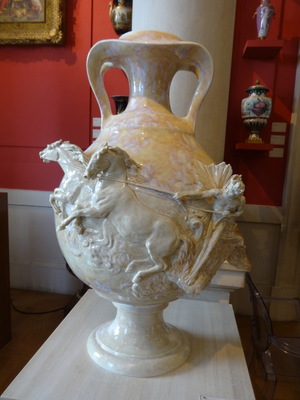
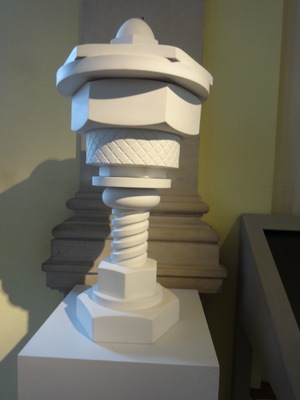 The vase at the left here was called "Day and Night," because figures representing those entities chased each other around it. It was made in 1897 (of hard boracic-based porcelain) from a model designed by Jean-Paul Aube (1837–1916).
The vase at the left here was called "Day and Night," because figures representing those entities chased each other around it. It was made in 1897 (of hard boracic-based porcelain) from a model designed by Jean-Paul Aube (1837–1916).
At the right is a fun "nuts and bolts" object. A pair of them flanked a short three-step stairway between rooms, and I couldn't find any label. They did seem to be porcelain, but I guess they were considered part of the room rather than objects on display.
The vases and urns displayed ranged from purely decorative, showing fruit, flowers, animals, natural objects (like sea shells and coral), or just geometric patterns in color and/or relief, to commemorative, showing scenes of battle or ceremonies. The "Vase d'Albi" commemorated the end of WWI with a series of scenes and the text of "the last dispatch."
Some of the most modern pieces were strange or downright bizarre. One, called "Constellation," was a pair of large fishnet bags filled with basket-ball-sized ceramic speres, each with a depiction of a constellation painted on it, in stylized stars joined by straight lines and the name of the constellation in block letters. Another, called "Treasure Island" consisted of a life-size ceramic tree stump surmounted by a ceramic human skull. On top of the skull was a full-color life-size bird (a blue tit). Perched on bumps on the sides or sticking out of knot holes in the trunk were many plain white, unpainted birds. And one more painted one (a chaffinch maybe?) lying on its back, dead. Puzzling.
One all white one called "study from Nature" seemed to be an extremely gaunt, headless, seated hound, with hugely swollen mammary glands.
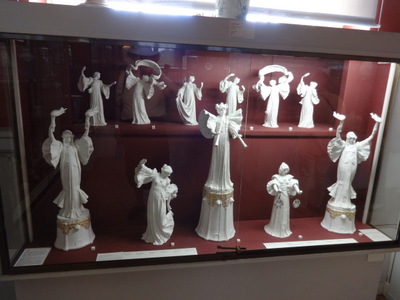
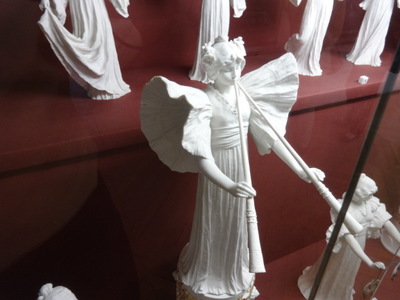 Returning to the more decorative items, here's a set of porcelain figurines made about 1900. The image one at the right is a closer detail of one of them, showing the gorgeous detail. Each one seemed to be called a "surtout" (meaning "above all" or "on top of everything"), so I'm not sure what they were for other than as decorative objects.
Returning to the more decorative items, here's a set of porcelain figurines made about 1900. The image one at the right is a closer detail of one of them, showing the gorgeous detail. Each one seemed to be called a "surtout" (meaning "above all" or "on top of everything"), so I'm not sure what they were for other than as decorative objects.
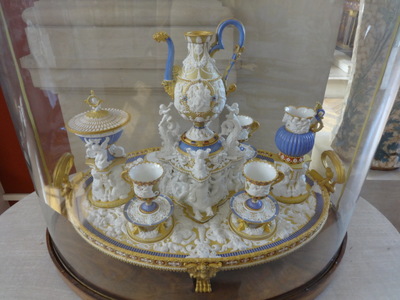
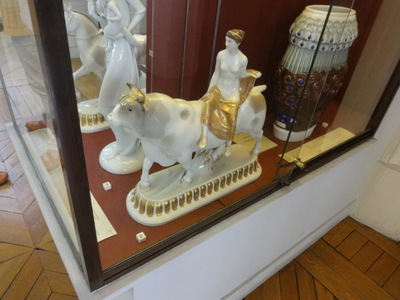 At the left here is an 1835 "Déjeuner de Fontainebleau" designed by Alexandre Fragonard. The description on the label did not make clear to me whether this breakfast set was made for the castle at Fontainebleau or whether it was just called that because its decoration evokes the decor of the grand gallery there. The detail is amazing.
At the left here is an 1835 "Déjeuner de Fontainebleau" designed by Alexandre Fragonard. The description on the label did not make clear to me whether this breakfast set was made for the castle at Fontainebleau or whether it was just called that because its decoration evokes the decor of the grand gallery there. The detail is amazing.
At the right is a piece that struck me mainly because it is the tamest representation I have ever seen of the Rape of Europa. The bull (Zeus in disguise) is advancing at a slow walk, if at all, and Europa seems content to sit there placidly and go along for the ride. At that rate, it's going to take them a heck of a long time to get to Crete.
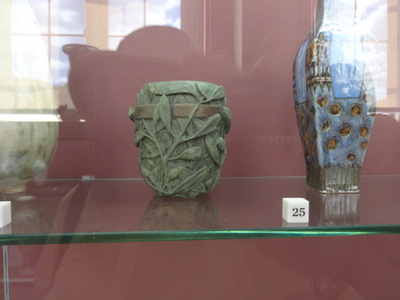
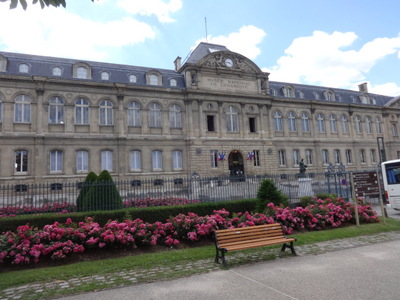 One last shot of a decorative plant motif. It's early 20th century, from northern France, and made of "grès," which in geology and architecture means sandstone but in pottery means stoneware. The label just calls it a cup, omitting any mention of the mistletoe pattern.
One last shot of a decorative plant motif. It's early 20th century, from northern France, and made of "grès," which in geology and architecture means sandstone but in pottery means stoneware. The label just calls it a cup, omitting any mention of the mistletoe pattern.
And finally, a parting shot of the facade of the museum as we start back across the bridge to catch the metro home. We stopped a stop short, at République, so that I could go to the Orange Boutique and top the phone up for our remaining week.
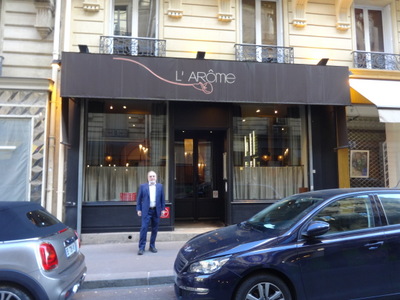
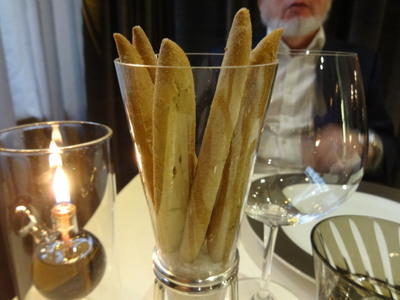 Dinner was at l'Arôme, "Aroma." Note the row of red Michelin restaurant guides in the window to the left of David, as well as the bright red Michelin sticker to the right. Since no macarons ("stars," we call them in English) are visible, I conclude that the restaurant has only one, the only number that could be completely hidden by David's hand. We of course chose it on the basis of its Gault-Millau rating.
Dinner was at l'Arôme, "Aroma." Note the row of red Michelin restaurant guides in the window to the left of David, as well as the bright red Michelin sticker to the right. Since no macarons ("stars," we call them in English) are visible, I conclude that the restaurant has only one, the only number that could be completely hidden by David's hand. We of course chose it on the basis of its Gault-Millau rating.
While we studied the menu, we munched on these little house-made breadsticks and a little dish of whitish dip with tiny red and green flecks in it (puréed beans, maybe).
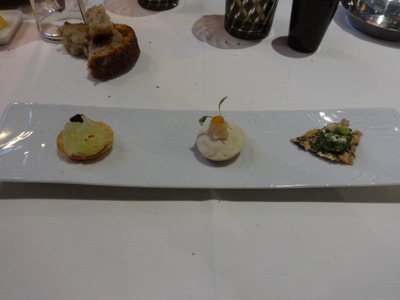
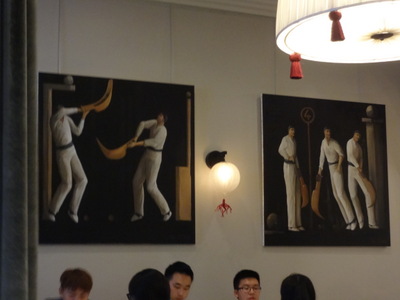 The "official" amuse-bouche, which came later, was (for each of us) this trio of three different kinds of cracker, each with something on top. I confess, I don't remember what they were, and I don't seem to have taken notes.
The "official" amuse-bouche, which came later, was (for each of us) this trio of three different kinds of cracker, each with something on top. I confess, I don't remember what they were, and I don't seem to have taken notes.
The walls were decorated with these paintings of "pelote Basque" (jai alai, more or less), from which we gathered that the food would be heavily influenced by the southwest of France.
The menu was structured such that we chose our main course, and all the others were set.

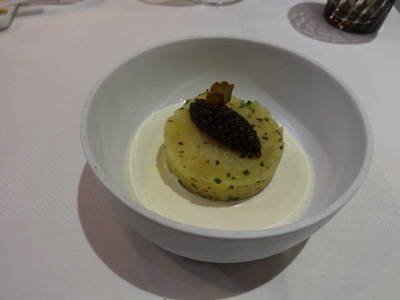 First course: a "tart" of cooked and raw vegetables (artichoke, carrot, radish, romaine, olives, leek, chives, borage flowers, all resting on a disk of crisp pastry)—sort of a standing salad. Tasty, pretty to look at, and fun to rummage through.
First course: a "tart" of cooked and raw vegetables (artichoke, carrot, radish, romaine, olives, leek, chives, borage flowers, all resting on a disk of crisp pastry)—sort of a standing salad. Tasty, pretty to look at, and fun to rummage through.
Second course: smoked potatoes. A neat timbale of very buttery crushed potato, laced with chives and tiny bits of something red and topped with caviar and the inevitable Oxalis leaf was served in a bowl in a pool of lemon cream. It arrived at the table covered by a dome, which was dramatically removed before us, releasing a little cloud of beechwood smoke.
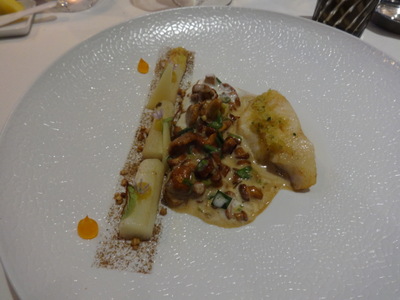
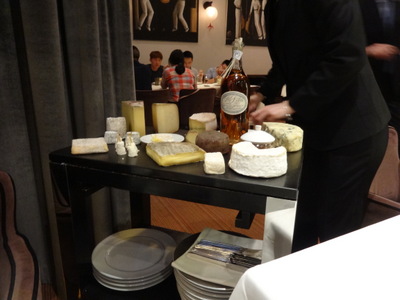 Third (main) course, which we both chose: John Dory and chanterelles with white asparagus, "citrus condiment," and puffed buckwheat grains. The sauce was of "ail des ours" ("bear garlic," a seasonal wild green) marbled with Arbois wine. As you can see, the chanterelles, although tasty, were of a size I wouldn't bother to bend over to pick. We asked that they omit the buckwheat grains from David's portion.
Third (main) course, which we both chose: John Dory and chanterelles with white asparagus, "citrus condiment," and puffed buckwheat grains. The sauce was of "ail des ours" ("bear garlic," a seasonal wild green) marbled with Arbois wine. As you can see, the chanterelles, although tasty, were of a size I wouldn't bother to bend over to pick. We asked that they omit the buckwheat grains from David's portion.
Then came two more dishes, not listed on the menu, which I don't have notes on and can't identify from the photos. Not outstandingly memorable ones, apparently.
The cheese trolley, on the other hand was both recognizable and memorable. In addition to the cheese, it bore a bottle of Vieux Pineau des Charentes, but neither of us partook of that.
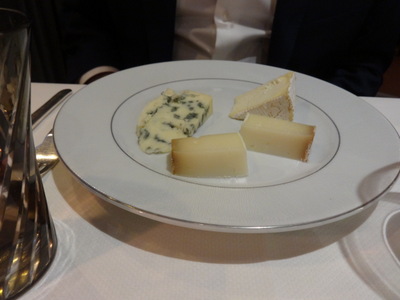
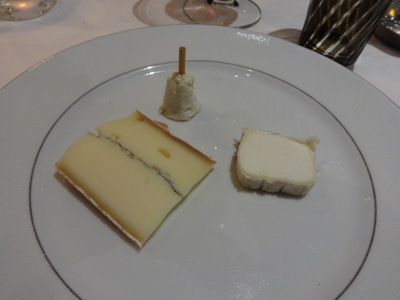 As usual, David chose a blue (I think it was Roquefort), some Brillat-Savarin, and a pressed, washed-rind thing (Beaufort, I think, or maybe Cantal).
As usual, David chose a blue (I think it was Roquefort), some Brillat-Savarin, and a pressed, washed-rind thing (Beaufort, I think, or maybe Cantal).
I, true to form, had a little "churn" of fresh chevre, a ripened rectangular chevre, and branching out a little, a slice of Morbier, with the characteristic streak of ash through the center.
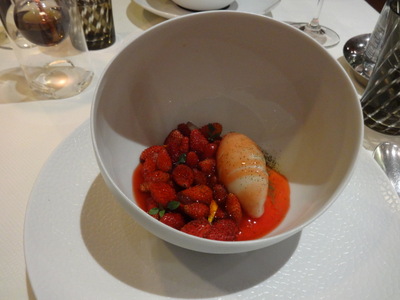
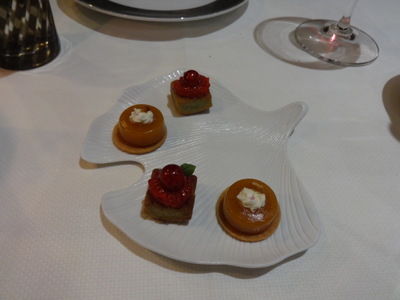 The dessert was excellent. First, they poured layer of panna cotta in the bottom of the dish, then when it had set, topped it with an artfully arranged heap of fraises des bois (wild strawberries), a quenelle of rose-flavored sorbet, and strawberry syrup. Yummy!
The dessert was excellent. First, they poured layer of panna cotta in the bottom of the dish, then when it had set, topped it with an artfully arranged heap of fraises des bois (wild strawberries), a quenelle of rose-flavored sorbet, and strawberry syrup. Yummy!
The mignardises came on this nice ginkgo-leaf-shaped plate: tiny caramel flans and little squares of cake topped with raspberry, glacé cherry, and basil. We didn't eat them.
Previous entry List of Entries Next entry